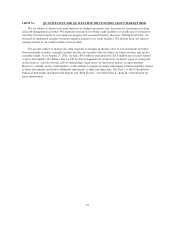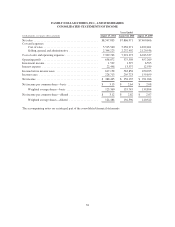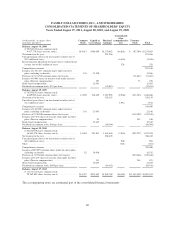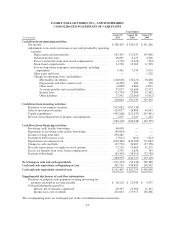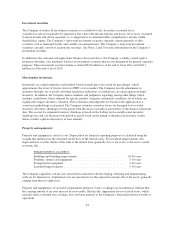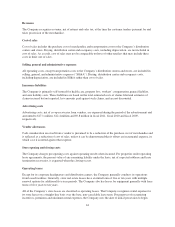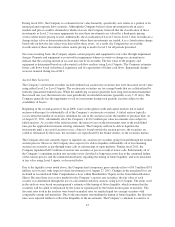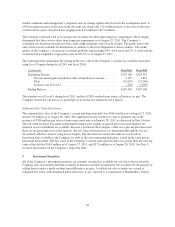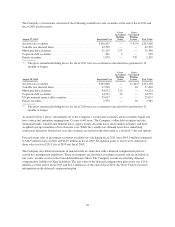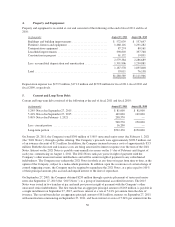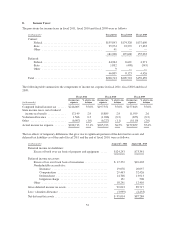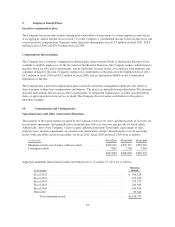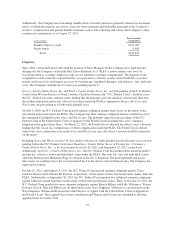Family Dollar 2011 Annual Report Download - page 49
Download and view the complete annual report
Please find page 49 of the 2011 Family Dollar annual report below. You can navigate through the pages in the report by either clicking on the pages listed below, or by using the keyword search tool below to find specific information within the annual report.amortization, which is generally when the Company enters the space and begins to make improvements in
preparation for intended use. For tenant improvement allowances and rent holidays, the Company records a
deferred rent liability at the inception of the lease term and amortizes the deferred rent over the terms of the
leases as reductions to rent expense on the Consolidated Statements of Income. See the “Revisions” section
below for information about the revision of the classification of the deferred rent liability in fiscal 2011.
Certain leases provide for contingent rental payments based upon a percentage of store sales. The Company
accrues for contingent rental expense as it becomes probable that specified sales targets will be met.
Income taxes
The Company records deferred income tax assets and liabilities for the expected future tax consequences of
temporary differences between the financial reporting basis and the income tax basis of its assets and liabilities.
The Company estimates contingent income tax liabilities based on an assessment of the probability of the
income-tax-related exposures and settlements related to uncertain tax positions. See Note 8 for more information
on the Company’s income taxes.
Stock-based compensation
The Company recognizes compensation expense related to its stock-based awards based on the fair value of the
awards on the grant date. The Company utilizes the Black-Scholes option-pricing model to estimate the grant-
date fair value of its stock option awards. The grant-date fair value of the Company’s performance share rights
awards is based on the stock price on the grant date. Compensation expense for the Company’s stock-based
awards is recognized on a straight-line basis, net of estimated forfeitures, over the service period of each
award. See Note 11 for more information on the Company’s stock-based compensation plans.
Revisions
Certain prior period amounts have been revised to conform to current classifications. The deferred rent liability
of $38.3 million as of August 28, 2010, previously classified as a current liability within Accrued Liabilities on
the Consolidated Balance Sheets, has been moved to Other Liabilities (non-current). The portion of deferred
income taxes related to deferred rent has also been revised and is now classified as non-current in the
Consolidated Balance Sheets. These changes were not material and had no impact on the consolidated statements
of earnings, shareholders’ equity or cash flows for any of the periods presented.
New accounting pronouncements
In April 2011, the Financial Accounting Standards Board (“FASB”) issued Accounting Standard Update
(“ASU”) 2011-04 “Fair Value Measurement: Amendments to Achieve Common Fair Value Measurement and
Disclosure Requirements in U.S. GAAP and IFRSs” (“ASU 2011-04”). ASU 2011-04 amends current fair value
measurement and disclosure guidance to include increased transparency around valuation inputs and investment
categorization. The new guidance is effective for fiscal year and interim periods beginning after December 15,
2011. The Company will adopt this guidance in the third quarter of fiscal 2012. The adoption of ASU 2011-04 is
not expected to have a material impact on the Company’s Consolidated Financial Statements.
In June 2011, FASB issued ASU 2011-05 “Presentation of Comprehensive Income” (“ASU 2011-05”). ASU
2011-05 allows an entity to present components of net income and other comprehensive income in one
continuous statement, referred to as the statement of comprehensive income, or in two separate, but consecutive
statements. The new guidance eliminates the current option to report other comprehensive income and its
components in the statement of changes in equity. While ASU 2011-05 changes the presentation of
comprehensive income, there are no changes to the components that are recognized in net income or other
45


